Physical Address
304 North Cardinal St.
Dorchester Center, MA 02124
Physical Address
304 North Cardinal St.
Dorchester Center, MA 02124
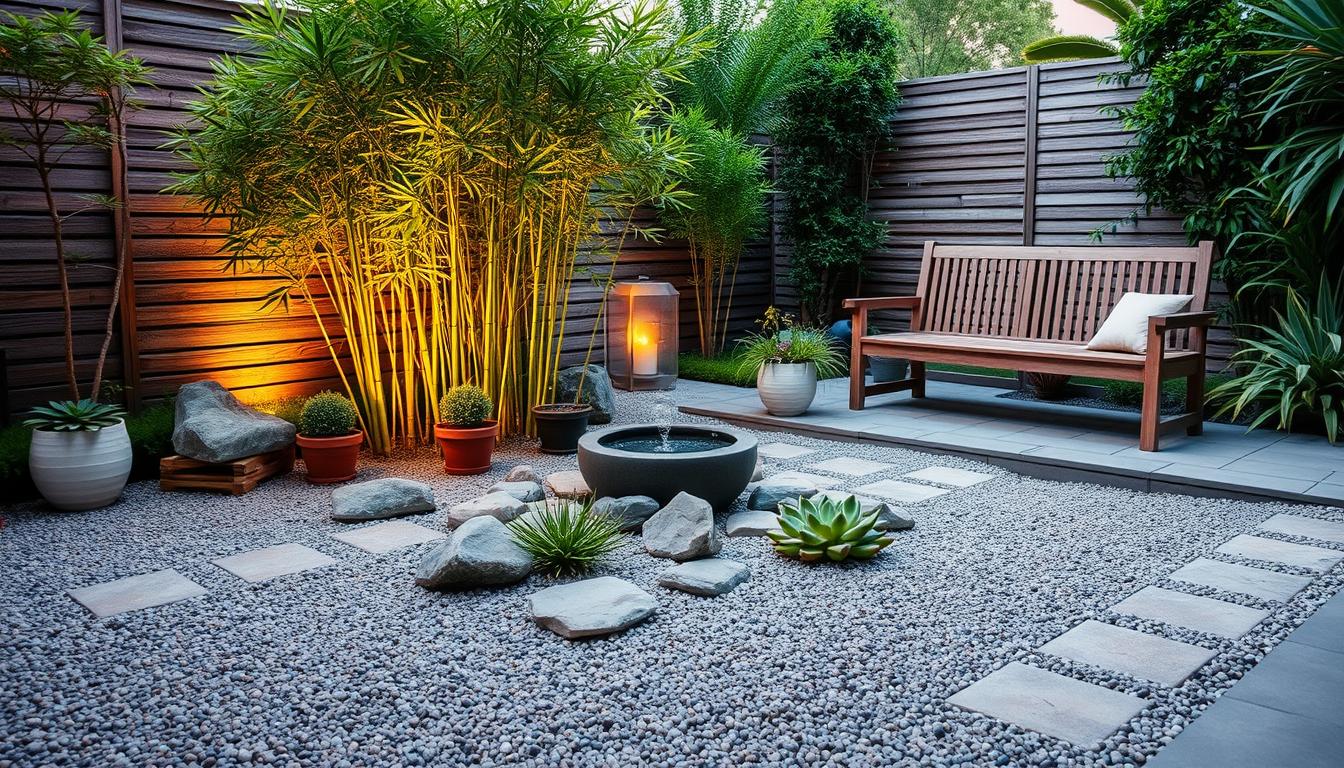
Imagine your ideal private spot outside. There, the soft sound of water calms you, and each detail brings peace. A Patio Zen Garden is more than just pretty. It’s a break from the busy world, a spot to relax and feel close to nature. It mixes Japanese beauty and thoughts, with things like sand, rocks, water, and special plants turning any patio into a peaceful place.
I once felt lost in the noise of daily tasks. Making a space with harmony and nature helped me escape. Even with a small patio, a simple Zen Garden became my refuge. I learned from experts like Melissa Reavis about using design for calm. I made a space for peace and self-reflection. It helped me find quiet in the loudness of life.
Now, let’s look at some ideas to make your Patio Zen Garden. A place where each part is both useful and beautiful. Even a tiny area can be your peaceful escape.
In a Japanese Rock Garden, choosing the right rocks and stones turns your yard into a calm haven. These elements symbolize nature’s strength and beauty. By placing Zen Garden Rocks carefully, your garden can reflect mountains, islands, or animals. This adds to its beauty.
Rocks do more than just look good in a Japanese Rock Garden. They create a peaceful mood and highlight points for meditation. Patricia Benner and Charles Mayer, landscape designers, say rocks bring depth and lasting beauty. For instance, smooth striped beach stones fit well in both old and new Zen gardens. These stones vary in size, making them great for any terrace size.
Finding the right rocks is key for your Zen garden’s feel. You can pick from small pebbles to large statement stones. Whether it’s pea gravel, basalt, or granite, each kind adds a unique look. Even driftwood and sea glass can enrich garden stories.
To make a unified Japanese Rock Garden, place your Zen Garden Rocks with care. Imagine the natural scenes you want to echo. Big stones act as focal points, while smaller ones can form paths or mimic water. But Zen gardens are not only about looks. They’re places for quiet and thought. Upkeep, like raking and stone arranging, keeps the garden peaceful.
Adding water features to your backyard can change its feel. They bring a visual and sound calmness. The soft noise of water can soothe your mind and make your area more peaceful.
Walking by a calm koi pond can be very relaxing. Start by picking Koi Pond Ideas that match your garden’s look. Choose bright water lilies and smooth pebbles. These not only look good but also give koi fish places to hide. A well-made koi pond can be the heart of your backyard, inviting calm and mindfulness.
A bamboo water fountain adds a timeless beauty. The sound of water flowing over bamboo helps with meditation and relaxation. These fountains fit perfectly in any Zen garden. They provide beauty and a calming atmosphere.
Water features need regular care to keep adding to your backyard’s calm. Here are some key maintenance tips:
Keeping up with these suggestions ensures your water features stay beautiful. They’ll always be a main attraction of your peaceful backyard oasis.
Making your Zen garden peaceful involves choosing the right plants. The right mix of plants makes the garden a calm place. You should consider the plants’ needs and meanings.
Selecting suitable plants is key for a Zen garden’s calm feel. Here are some great plant choices that are easy to care for:
Adding moss and bamboo makes a Zen garden a haven. Moss is easy to grow and keeps places looking calm and green. It loves shade and asks for little care.
Bamboo is great for adding privacy and green all year. It grows fast and can be used to make borders or highlight vertical space. A smart bamboo setup brings depth and character.
Here’s how you can use these plants to make a peaceful area:
With the right plants thoughtfully placed, your Zen garden will not only look good. It will also bring peace into your life.
Raking sand in Zen gardens is more than just an art. It’s a way to find calmness in our minds. The patterns of sand and rocks mimic water, bringing peace and focus.
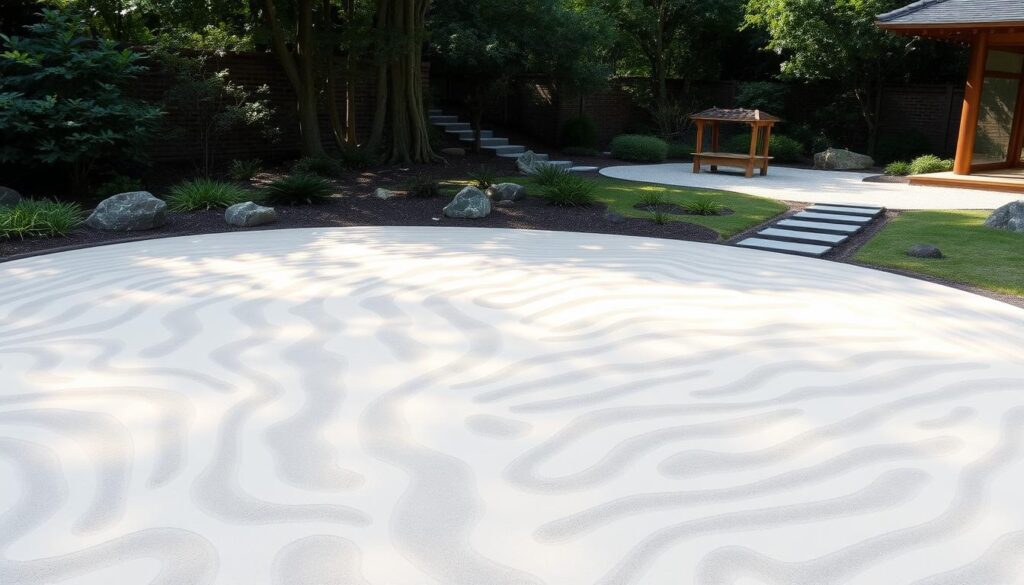
The sand you choose is key to your Meditation Garden’s beauty. Fine-grain sand is best as it keeps designs well. Adding colored sand brings a pop of creativity to your peaceful space.
Learning to rake properly is crucial in Zen gardening. It’s not just about the look; it’s active meditation. Practicing these patterns helps us find deeper peace and self-reflection.
Landscape experts like Molly Wood show us how. They say the way we draw patterns can make our spaces calm and welcoming. You can use a zen rake or something simple, like forks. What matters is the mindfulness in each move.
As evening falls, the right lighting makes a Zen garden glow, enhancing an Outdoor Meditation Space. It turns it into a Tranquil Backyard Oasis. Use gentle and well-placed lights to boost your garden’s night atmosphere.
Different lights suit your Zen Garden Lighting needs, each with its own perks:
Putting lights in the right spots is key for a peaceful garden. Keep these ideas in mind:
To spotlight the best parts of your garden:
With the right Zen Garden Lighting, your simple garden turns into an impressive Outdoor Meditation Space. It fosters relaxation and peace.
Gravel gardens are great for those who love beauty but hate the hard work. Adding gravel garden ideas to your space makes it peaceful yet easy to take care of. Gravel not only looks good, but it also makes your garden feel calm.
It’s important to pick the right gravel for your Zen garden. Some top picks are:
Gravel paths aren’t just easy to keep up; they look great too. Some benefits include:
Mixing in pebble garden ideas with your gravel can add even more style. With these gravel garden ideas, your garden will feel peaceful and welcoming. It’s perfect for quiet time and enjoying nature.
To make a peaceful Small Space Zen Garden, focus on using elements wisely in a small area. Experts say using simple designs helps make the area look clean and open. This makes the Small Japanese Garden calm and balanced. Here are key Garden Landscaping Design Ideas to transform your space.
Creating a Small Japanese Garden in tight spaces needs careful planning. Use tall bamboo or tiered water features to add depth. This makes the Small Space Zen Garden feel larger. Placing big stones and gravel in patterns can also create a peaceful, natural look.
For a great Small Japanese Garden, using space well is key. Plant low-maintenance succulents that need little space and love the sun. Adding small wooden things like benches or lanterns keeps it simple but charming. Including a small fountain can also bring peace with its soft water sound.
Integrating Japanese Maple trees into your Japanese Garden Landscape boosts beauty and peace. These trees are known for their beautiful leaves. They transform any area into a calm place. They fit well in many garden designs. Here, we’ll look at the different types of Japanese Maple trees. You’ll also get tips on how to take care of them.
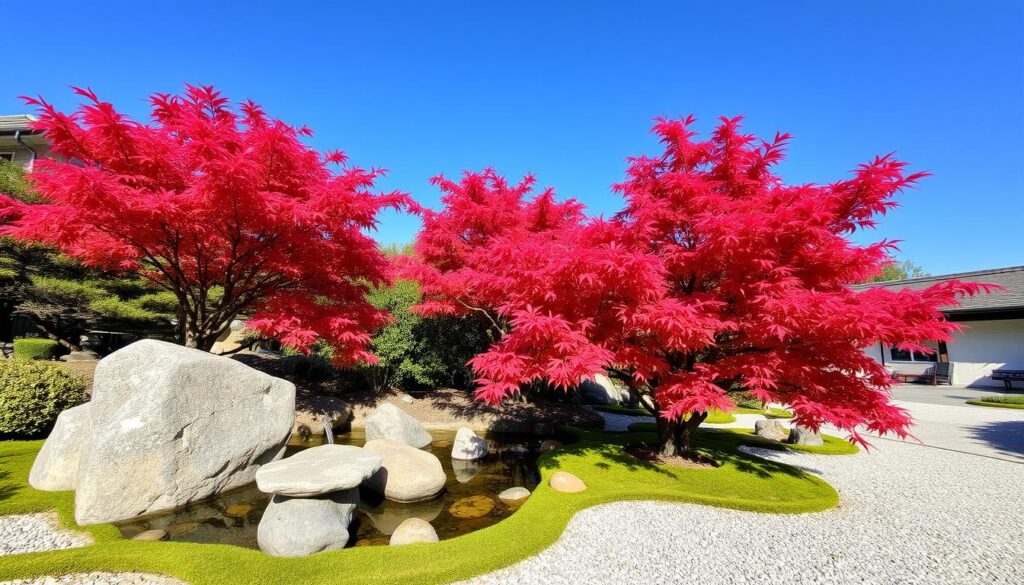
Japanese Maple trees have many types. Each type has its own colors and shapes. This adds a lot to a Japanese Garden Landscape.
To keep Japanese Maple trees healthy, follow these tips:
Choosing the right trees and caring for them makes your garden better. With these easy plants, your garden will be beautiful. It will be a calm place to enjoy nature.
Adding a Japanese Zen Garden to your patio can mix old and new, giving you a peaceful escape. It doesn’t matter if you live in a busy city or a calm suburb. Your outdoor area can become a soothing space. Let’s look at how to bring in the right details for a true Zen feeling.
1. Stone Lanterns: These classic pieces add timeless charm and serenity to your garden.
2. Pebble Paths: Soft-looking paths guide you through your Zen space, adding texture and depth.
3. Raked Sand Areas: These are perfect for meditation, helping you find peace and clarity.
4. Koi Pond: A water feature like a koi pond brings lively vibes to your garden. The sound of water creates a calm environment.
5. Bamboo Water Fountain: These fountains add soft, soothing sounds, making your garden more serene.
6. Mossy Accents: Moss brings greenery and an ancient look to your garden’s design.
7. Minimalist Seating: Simple seating invites relaxation and self-reflection.
8. Gravel Features: Gravel makes for easy-to-care-for sections, adding texture and a minimalist touch.
9. Stone Arrangements: Carefully placed stones add balance and harmony to your Zen garden.
10. Miniature Trees: Small trees or bonsais bring a vertical dimension to your garden.
11. Nature-Inspired Sculptures: Art pieces can be central points for deeper thought in the garden.
12. Garden Lighting: Gentle lighting at night highlights your garden’s beauty.
13. Bamboo Elements: Bamboo can be used in fencing or water features, adding authenticity.
14. Meditation Spots: Create private areas for meditation within your Japanese Zen Garden.
15. Natural Dividers: Small plants or bushes can mark different areas within the garden.
16. Seasonal Blooms: Choose plants that bloom at different times for year-round beauty.
17. Textural Variety: Mix pebbles, stones, and moss for a full sensory experience.
18. Historical Touches: If your garden is in a historical area, keep some old features.
19. Wildlife-Friendly Features: Add a butterfly waystation or similar to support local animals.
20. Victorian Herb Garden: A herb garden adds a practical and fragrant element to a modern Zen space.
With these features, your Patio Zen Garden will be a beautiful part of your home. It’s perfect for finding peace and deep thought.
Creating a dedicated Meditation Garden Design in your Zen garden boosts spiritual and relaxation benefits. Use flat stones, low benches, or cushioned platforms for seating. These options mix well with nature. Let’s dive into creating your perfect Outdoor Meditation Space.
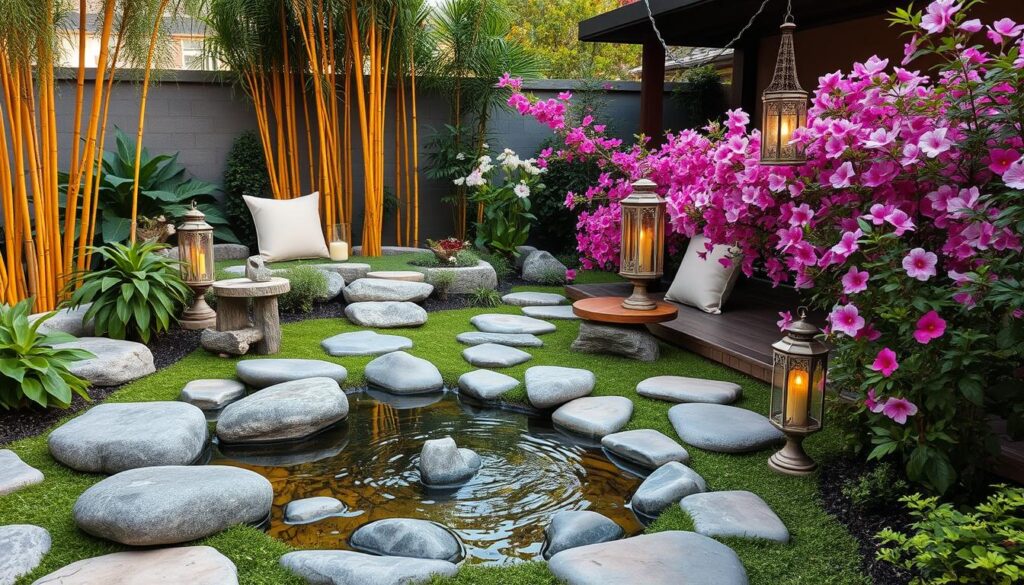
A well-planned meditation area is essential for a Tranquil Backyard Oasis. You should adopt Zen garden ideas like simplicity and naturalness. Pick a quiet spot away from busy areas.
Use gravel and large rocks for a peaceful setting. Add plants like moss or bamboo for a natural feel. Thoughtful lighting also makes the area calm and welcoming.
The right furniture makes your outdoor area a great Meditation Garden Design. Choose low benches or decorative stones for simple seating. A cushioned platform adds comfort and blends with nature.
Consider an oil diffuser with soothing scents or a soundproof tapestry to enhance your meditation. Use floating shelves for calming decor and add DIY artwork to bring personal touch to your Outdoor Meditation Space.
Creating pathways in your Zen garden does more than lay out where to walk. These paths lead to self-discovery, promoting mindfulness and peace. When picking materials for your Garden Path Design, choose options that gently stimulate the senses. For example, stepping stones, packed gravel, or sleek wooden planks work well.
Zen Garden Pathways not only beautify your space but also add calm functionality. Imagine a path that mimics a dry riverbed, snaking through flowers for a charming sensory journey. Or, picture a pebbly trail lined with soft grasses and drought-tolerant plants, showcasing a rugged beauty like in Paso Robles, CA.
The design choices are vast:
If you love traditional Japanese Walkways, think about using concrete pavers with fractured shale. Or stepping stones placed among vibrant greenery in a Northwest style garden. Even slim grass paths make a big difference, especially when they replace large lawns with curved flower beds.
Choosing the right paths makes your Zen garden feel unified and serene. By carefully selecting materials and styles, you can craft Zen Garden Pathways that turn your garden into a peaceful sanctuary.
Japanese Garden Bridges are not just for getting across. They mean more, bridging the earthly to the spiritual. They bring different parts of the garden together. This makes the garden more harmonious and beautiful. Adding a bridge can change your garden into a peaceful place for thought.
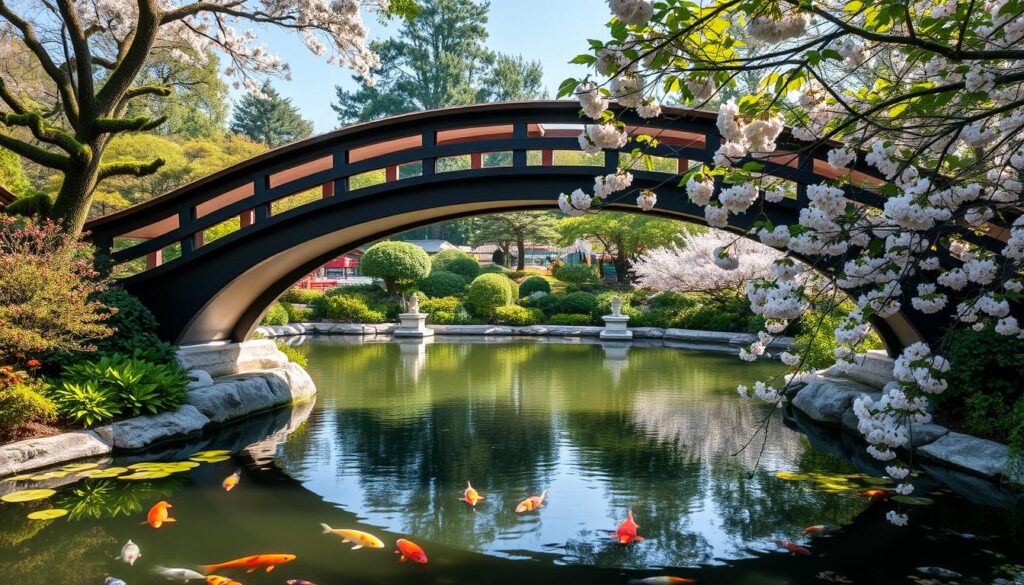
There are many bridges to choose from for your garden. Here are some favorites:
Planning your bridge’s design is crucial for a balanced garden. Here’s what to think about:
We aim to craft a space for deep thoughts and calm. The right Japanese Garden Bridges, when thoughtfully chosen and positioned, make your garden a natural retreat. Then, it becomes a place for quiet and deep thinking.
In a Japanese Style Garden, sculptures and statues create a peaceful space. They make the garden look better and have deep meanings. These meanings match with the Zen Garden Design ideas.
The Buddha statues are very popular, with 105 different kinds available. They’re made from materials like glass, metal, resin, stone, ceramic, and wood. This shows the huge influence of Zen art worldwide. Artists from everywhere craft these beautiful pieces, in many sizes, styles, and colors. You can find the perfect one for your garden.
Where you place garden sculptures matters a lot in a Zen Garden Design. For example, Buddha statues look best when they’re set near things like rocks or water. This setup makes a space that helps you feel calm and think deeply. It’s also a common feature in small Zen gardens at homes or offices.
Adding sculptures to outside Zen gardens is becoming more popular. It’s all about making a quiet spot to relax. Taking care of the garden, like raking or trimming plants, helps too. This way, your garden becomes a peaceful retreat for quiet thoughts.
Bamboo brings beauty and function to any space. It improves the look of your garden and offers a low-maintenance landscaping option. Learn how bamboo garden design can upgrade your Zen garden.
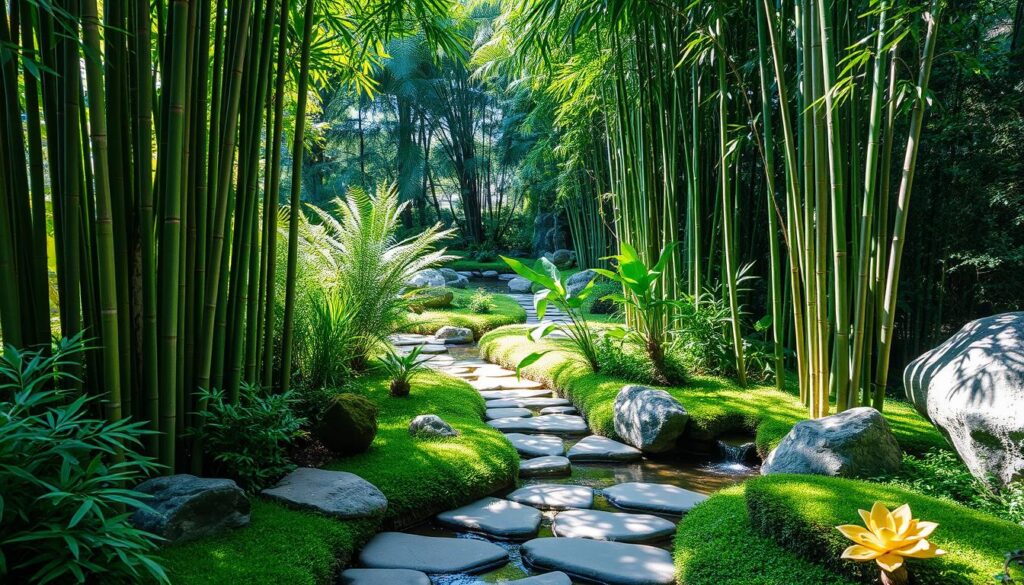
In Japanese garden design ideas, bamboo is used for privacy screening. You can choose from different types like Bambusa multiplex and Phyllostachys nigra. Ma-Dake can reach up to 20 meters, making a gorgeous and effective barrier.
Bamboo is popular for being sustainable. It’s tough, adaptable, and makes great fencing material. It can be shaped to fit your garden perfectly.
“The gentle rustling of bamboo leaves creates a soothing backdrop, contributing to the sensory experience of your Zen garden.”
Bamboo can also be used for structures like pergolas or bridges in your Japanese garden. Its natural look goes well with other garden parts. This creates a peaceful and beautiful atmosphere.
Keep these points in mind for your bamboo garden design:
Bamboo Type: Pick the right kind for your needs, like Bambusa multiplex or Phyllostachys sulphurea.
Maintenance: It needs regular watering and some pruning to look good and grow right.
Placement: Place it carefully for privacy and beauty.
Choosing bamboo means less work in the garden. Clumping varieties especially don’t need much trimming or control. This makes bamboo a top pick for a calm, easy-care Zen garden that follows Japan’s garden design principles.
Turning your home into a peaceful retreat is possible with an indoor Zen garden. These gardens bring the calm and beauty of nature inside. They fit perfectly in smaller spaces inside.
We will explore designing these peaceful spaces. They can make our lives more serene and joyful.
Indoor and outdoor Zen gardens share the same core ideas. But, they are set up differently due to space and environment. An Indoor Japanese Garden uses pots and trays for sand, stones, and plants. This is because there’s less room. Outdoor gardens, on the other hand, can spread out more naturally.
Space Utilization: Indoor gardens get creative with limited space. They might use shelves or small versions of traditional parts.
Element Exposure: Inside, you don’t have the weather helping out. So, good lighting and air movement are key.
Versatility: You can put an indoor Zen garden in many spots. Like your living room, office, or near the entrance. This makes them very flexible to design.
The aim is always the same. A space that makes us stop and find peace.
An indoor Zen garden needs certain things to make it whole. Here’s what your Miniature Garden Design should have:
Building a Small Zen Garden at home gives you a quiet spot for thought. Using these elements well creates a place for you to be calm and creative.
Adding pebbles to your Zen garden brings a beautiful texture and a subtle contrast. This enhancement betters the look and feel of the space. Whether it’s a Japanese Rock Garden or a Small Space Zen Garden, pebbles are key. They change the area into a calm and thoughtful retreat. Let’s look into some smart Pebble Garden Ideas for your Zen place.
Kohei Owatari, known for modern Zen gardens, stresses the importance of well-designed elements. His award-winning project used Mexican Beach Pebbles beautifully. It shows how pebbles create serene and useful outdoor areas.
Mixing old and new Zen garden designs creates perfect harmony. It combines history’s charm with today’s style. Key Japanese garden elements like water, plants, and rocks are used. Adding modern touches, like straight lines and new sculptures, gives the garden a fresh look.
The wisdom of Japanese garden design comes from Buddhism, Shinto, and Taoism. It suggests making small scenes that unfold slowly, for deep thought. Pruned trees show off their shape, and evergreens offer beauty all year. New Zen gardens include fast-growing bamboo for beauty and structure.
Modern Zen gardens mix unusual materials with traditional ones. Think sleek metals with classic stone lanterns. Or recycled items with raked gravel that represents waves. This blend honors Zen beliefs while showing off personal style through creative design. Embracing these ideas makes spaces calm, beautiful, and perfect for quiet reflection.